2017 AUDI TT ROADSTER width
[x] Cancel search: widthPage 249 of 314
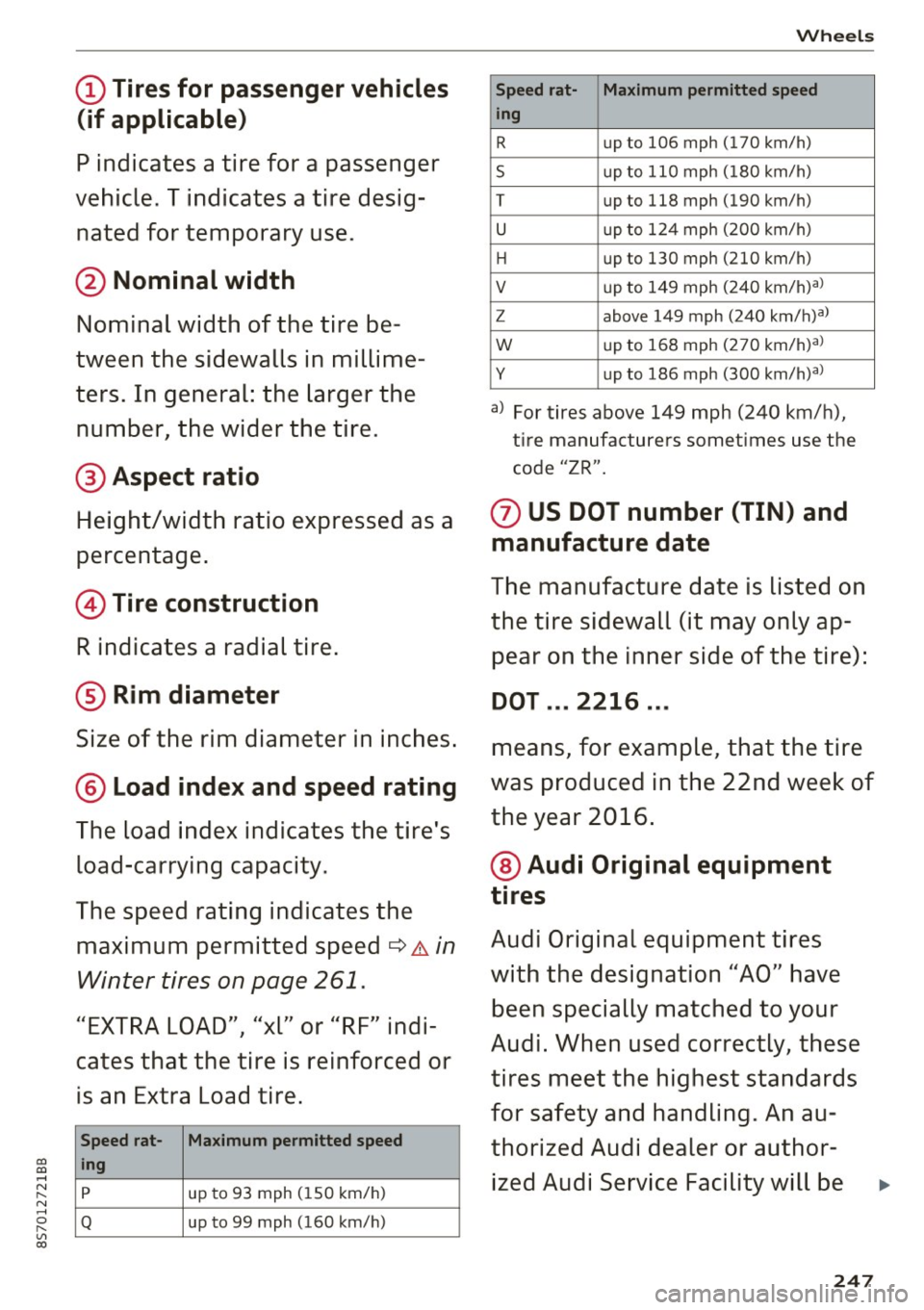
co
co
.... N
" N .... 0
" "' c:o
(D Tires for passenger vehicles
(if applicable)
P indicat es a tir e for a p asse ng er
vehi cle. T indi cates a tire de sig
nated for tempor ary us e.
@ Nominal width
Nominal width of the tire be
tween the sidew alls in millime
ters. In general: the larger the number, the wider the tire.
@ Aspect ratio
Height /width ratio expressed as a
percentage.
@ Tire construction
R indicates a radial tire.
® Rim diameter
Siz e of the rim diameter in inches.
@ Load index and speed rating
The load ind ex indi cates the tire' s
lo ad-ca rry in g ca pacity.
The speed rating indicates the maximum permitted speed¢.&
in
W inter tires o n page 261 .
"EXTRA LOAD", "xl" or "RF" indi
cate s that the tire i s reinfor ced or
is an Extra Load tire.
Speed rat- Maximum permitted speed
ing
p
up t o 93 mph ( 150 km/h)
Q up to 99 mph (160 km/ h)
Wheels
Speed rat- Maximum permitted speed
ing
R up to 106 mph (170 km/h)
s u p to 11 0 mph ( 180 km/h)
T up to 118 mph (190 km/h)
u u p to 124 mph ( 200 km/h)
H up to 130 mph (210 km /h)
V u p to 14 9 mph (2 40 km/h) al
z above 149 mph (240 km/h)al
w up to 168 mph (270 km/h)al
y up to 1 86 mph (300 km/h)al
a) For tir es ab ove 149 mph (2 40 km/h),
t ir e man ufact ure rs sometimes use the
co de "Z R".
(j) US DOT number (TIN) and
manufacture date
The m anufac ture date i s listed on
the tire sidewall (it ma y only ap
pear on the inner side of the tire):
DOT ... 2216 ...
means, for example , that the tire
was produced in the 22nd week of
the year 2016.
@ Audi Original equipment
tires
Audi Original equipment tire s
with th e designation "AO " hav e
b een specially mat ch ed to your
Audi. When u sed correctly, thes e
tires meet the high est stand ards
for safety and handling. An au
thorized Audi dealer or author
ized Audi Service Facility will be
247
Page 250 of 314

Wheels
able to provide you with more in
formation.
® Mud and snow capability
"M/S" or "M+S" indicates the tire
has properties making it suitable
to drive in mud or snow.
& indi
cates a w inter t ire.
@ Compos ition of the tire cord
and materials
The number of plies indicates the
number of rubberized fabric lay
ers in the tire . In general: the
more layers, the more weight a
tire can carry. Tire manufacturers must also specify the materia ls
used in the tire. These include
steel, nylon, polyester and other
materials .
@ Maximum permitted load
This number indicates the maxi
mum load in k ilograms and
pounds that the tire can carry.
@ Uniform tire quality grade
standards for treadwear,
traction and temperature
resistance
Tread wear, t raction and temper
ature ranges ¢
page 262.
248
@ Running direction
~ Maximum permitted
inflation pressure
This number indicates the maxi
mum pressure to wh ich a t ire can
be inflated unde r normal operat
ing condit ions .
Glossary of tire and loading
terminology
Accessory weight
means the combined weight (in
excess of those standard items
which may be replaced) of auto
matic transmission , power steer
ing , power brakes , power win
dows, power seats , radio, and
heater, to the extent that these
items a re available as fac tory-in
stalled equipment (whet her in
stalled or no t).
Aspect ratio
means the rat io of the height to
the width of the tire in pe rcent.
Numbers of 55 or lower indicate a
low sidewall fo r imp roved steer
ing response and better overa ll
handling on dry pavement .
Bead
means the part of the tire that is
made of steel wires, wrapped or ...
Page 252 of 314
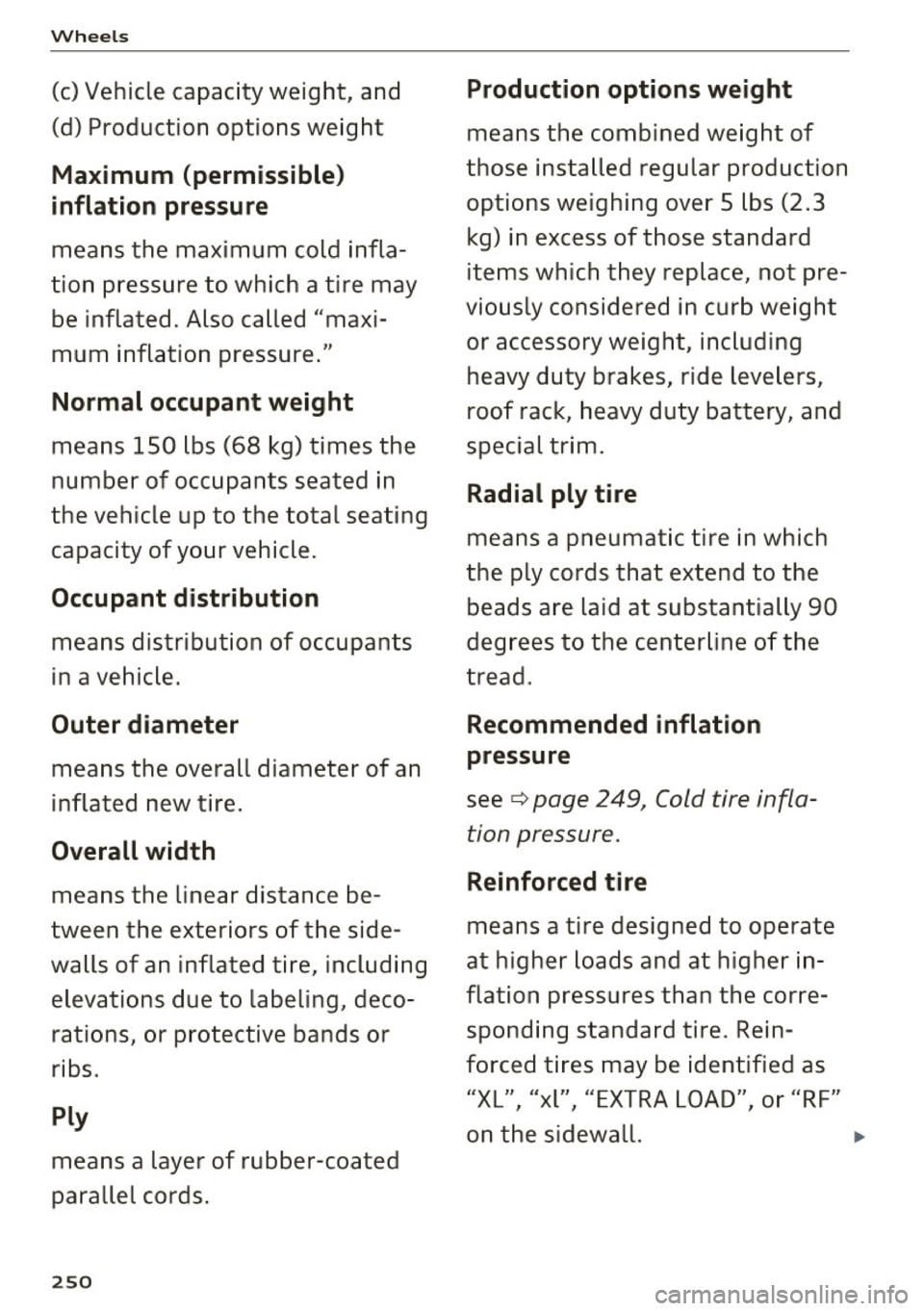
Wheel s
(c) Vehicle capaci ty weight, and
(d) Production options we ig ht
Maximum (permissible)
inflation pressure
means the maximum cold infla
tion pressure to which a tire may be inflated . Also called "max i
mum i nflation pressure ."
Normal occupant weight
means 150 lbs (68 kg) times the
number of occupants seated in
the vehicle up to the to tal seat ing
capacity of your vehicle .
Occupant distribution
means distribution of occupants
in a vehicle.
Outer diameter
means the overall diameter of an
inflated new tire.
Overall width
means the linear distance be
tween the exteriors of the side
walls of an inflated tire, inc luding
e levations due to label ing, deco
rations, or protective bands or
ribs .
Ply
means a layer of rubber-coated
parallel cords .
250
Production options weight
means the combined weight of
those installed regular product ion
options weighing over 5 lbs (2.3 kg) in excess of those standard
items which they replace, not pre
viously considered in curb weight or accessory weight, including
heavy duty brakes , ride levelers,
roof rack, heavy duty ba ttery, a nd
special trim.
Radial ply tire
means a pneumatic tire in which
the ply cords that extend to the
beads are la id at substantially 90
deg rees to the centerline o f the
tread.
Recommended inflation
pressure
see ¢ page 249 , Cold tire infla
tion pressure.
Reinforced tire
means a tire designed to operate
at higher loads and at higher in
flation pressures than the corre
sponding standard tire . Rein
forced tires may be identified as "XL", "xl", "EXTRA LOAD", or "RF"
on the s idewall. ...
Page 253 of 314
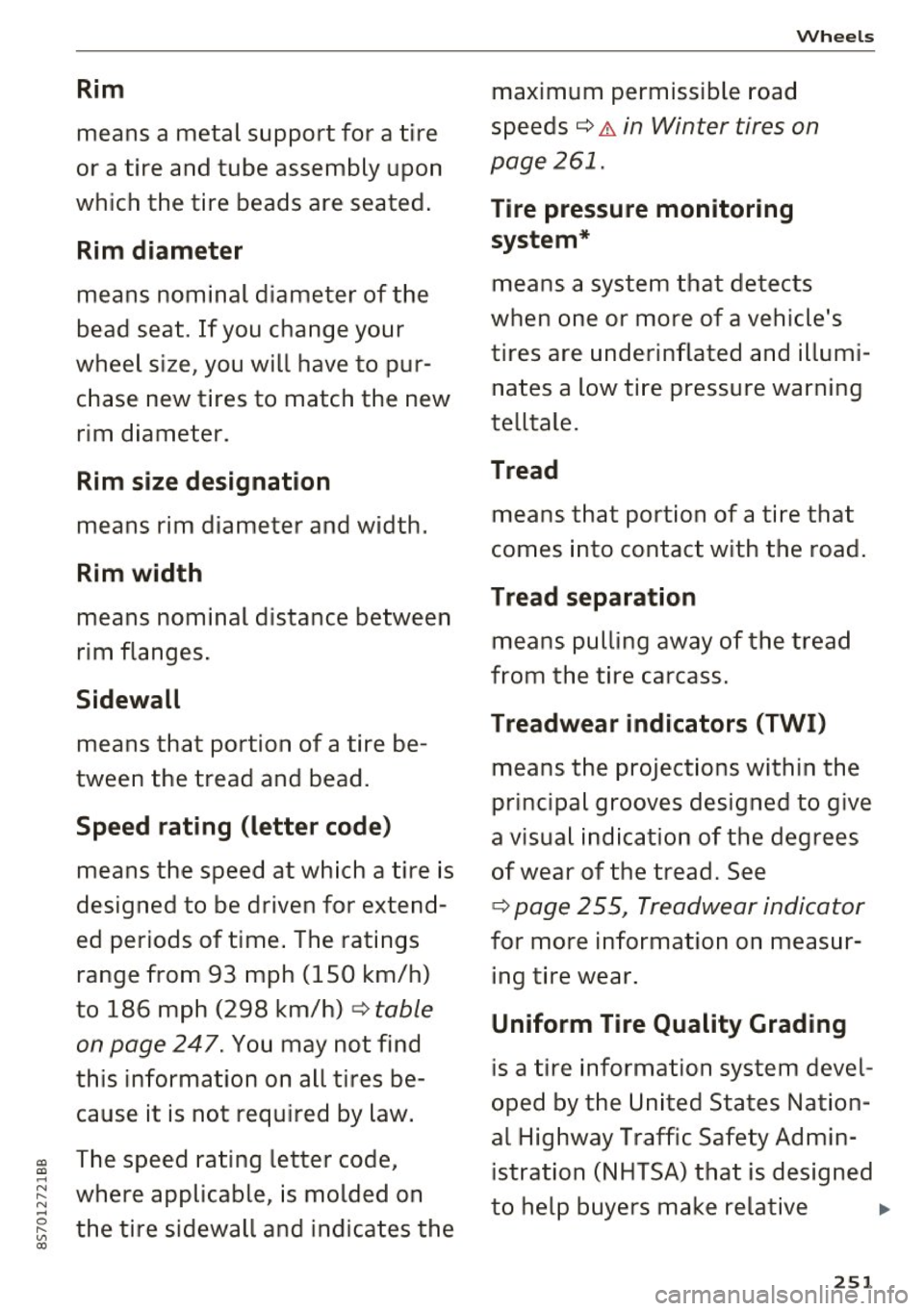
a, a, .... N
" N .... 0
" V, a:,
Rim
means a metal support for a tire
or a tire and tube assembly upon
which the tire beads are seated.
Rim di amet er
means nominal diameter of the
bead seat. If you change your
wheel size, you will have to pur
chase new tires to match the new
rim diameter.
Rim size designation
means rim diameter and width.
Rim width
means nominal distance between
rim flanges.
Sidewall
means that portion of a tire be
tween the tread and bead.
Speed rating (letter code )
means the speed at wh ich a tire is
designed to be driven for extend
ed periods of time . The ratings
range from 93 mph (150 km/h)
to 186 mph (298 km/h)
¢ table
on page 247.
You may not find
this information on all tires be
cause it is not required by law.
The speed rating letter code,
where applicable, is molded on
the tire sidewall and indicates the
Wheels
maximum permissible road
speeds
¢ A in Winter tires on
page 261.
T ire pressure mon itoring
system *
means a system that detects
when one or more of a vehicle's
tires are underinflated and illumi
nates a low tire pressure warning
telltale.
T read
means that portion of a tire that
comes into contact with the road .
Tread separation
means pulling away of the tread
from the tire carcass.
Treadwear indicators (TWI )
means the projections within the
principal grooves designed to give
a visual indication of the degrees
of wear of the tread. See
¢ page 255, Treadwear indicator
for more information on measur
ing tire wear .
Uniform Tire Quality Grading
is a tire information system devel
oped by the United States Nation
a l Highway Traffic Safety Admin
istration (NHTSA) that is designed
to help buyers make relative
25 1
..
Page 262 of 314
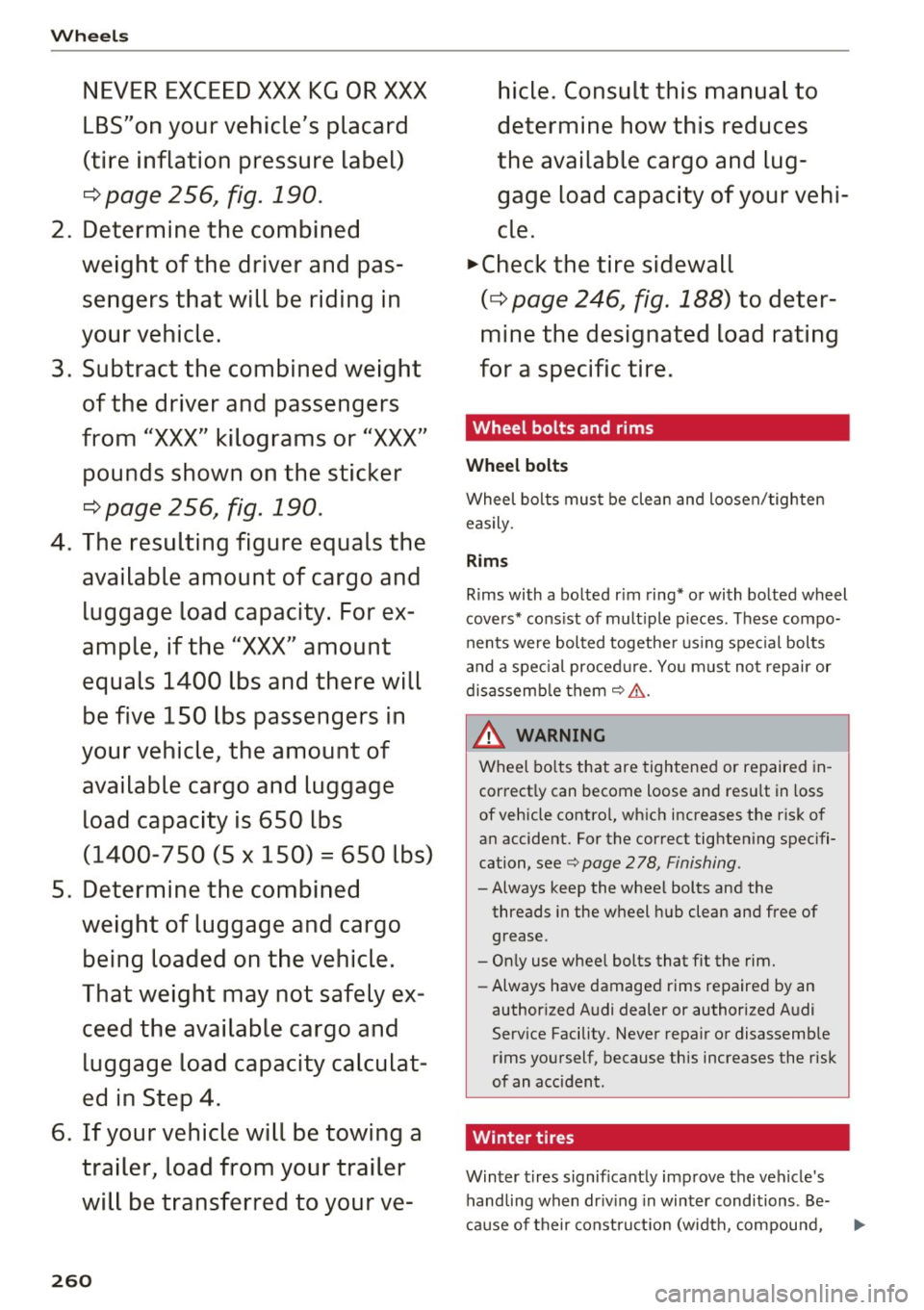
Wheels
NEVER EXCEED XXX KG OR XXX
LBS"on your vehicle's placard
(tire inflation pressure label)
¢ page 256, fig. 190.
2. Determine the combined
weight of the driver and pas
sengers that will be riding in
your vehicle.
3. Subtract the combined weight
of the driver and passengers
from
"XXX" kilograms or "XXX"
pounds shown on the sticker
¢ page 256, fig. 190.
4. The resulting figure equals the
available amount of cargo and
luggage load capacity. For ex
ample, if the "XXX" amount
equals 1400 lbs and there will
be five 150 lbs passengers in
your vehicle, the amount of available cargo and luggage
load capacity is 650 lbs
(1400-750 (5
X 150) = 650 lbs)
5. Determine the combined weight of luggage and cargo
being loaded on the vehicle.
That weight may not safely ex ceed the available cargo and luggage load capacity calculat
ed in Step 4.
6. If your vehicle will be towing a
trailer, load from your trailer
will be transferred to your ve-
260
hicle. Consult this manual to
determine how this reduces
the available cargo and lug
gage load capacity of your vehi
cle.
~check the tire sidewall
(¢ page 246, fig. 188) to deter
mine the designated load rating
for a specific tire.
· Wheel bolts and rims
Wheel bolts
Wheel bolts must be clean and loosen/tighten
easily.
Rims
Rims with a bolted rim ring* or with bolted wheel
covers* consist of multiple pieces. These compo
nents were bolted together using special bolts
and a special procedure. You must not repair or
disassemble them
¢ &..
_8. WARNING
-Wheel bolts that are tightened or repaired in
correctly can become loose and result in loss
of vehicle control, which increases the risk of
an accident. For the correct tightening specifi
cation, see
¢ page 2 78, Finishing.
- Always keep the wheel bolts and the threads in the wheel hub clean and free of
grease .
- Only use wheel bolts that fit the rim.
- Always have damaged rims repaired by an
authorized Audi dealer or authorized Audi
Service Facility . Never repair or disassemble
rims yourself, because this increases the risk
of an accident .
Winter tires
Winter tires significantly improve the vehicle's
handling when driving in winter conditions . Be-
cause of their construction (width, compound, ..,.
Page 264 of 314
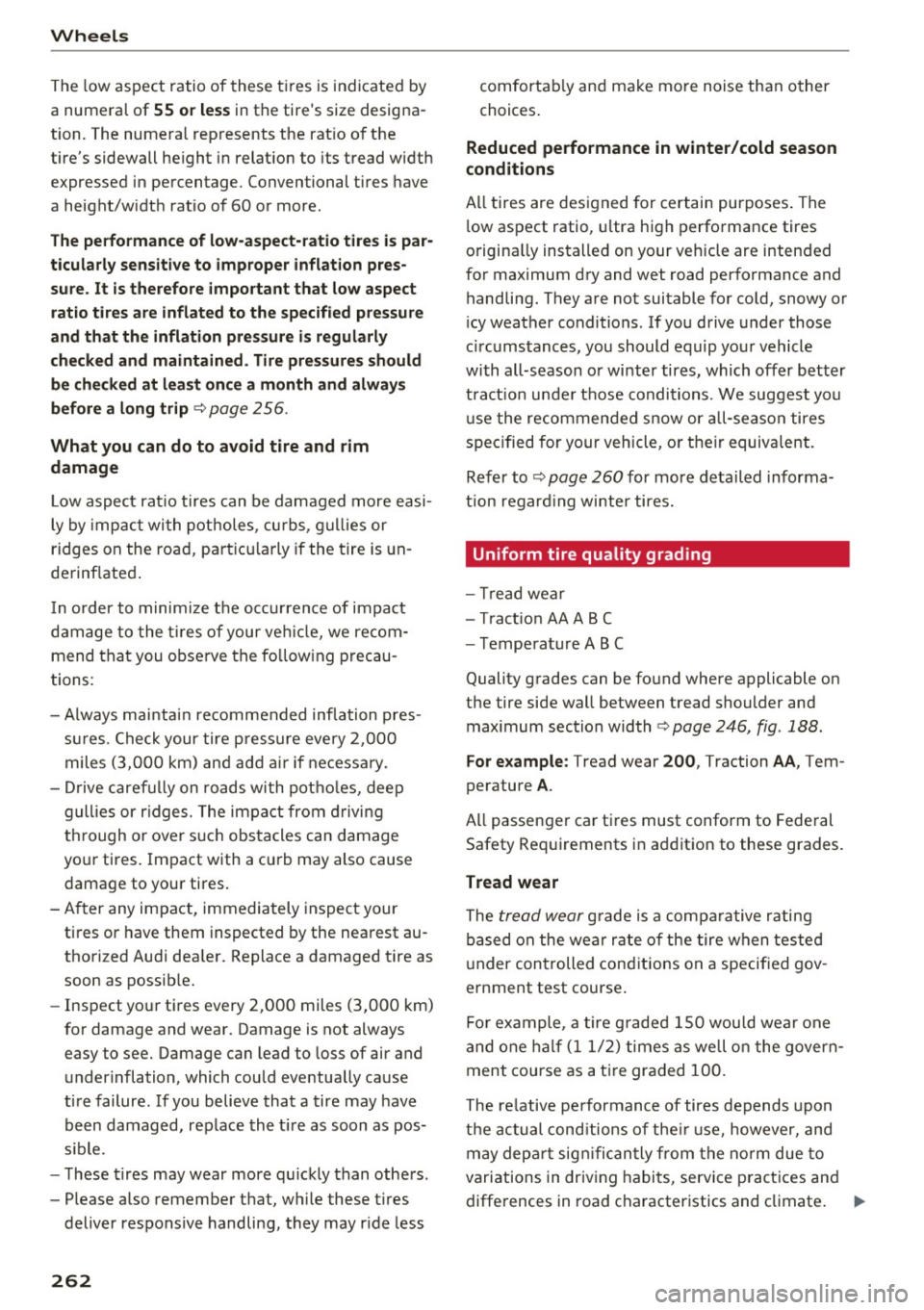
Wheels
The low aspect ratio of these tires is i ndicated by
a numeral of
55 or less in the tire's si ze designa
tion. The numera l rep resents the rat io o f the
tire's sidewall he ight in relat ion to its tread width
expressed in percentage . Conventional tires have
a height/w idt h rat io of 60 o r more.
The performance of low -aspect-ratio tire s is par ·
ticularly sensitive to improper inflation pres
sure.
It i s therefore important that low aspect
ratio tires ar e inflat ed to the specifi ed pr essure
and that the inflation pre ssure is regularly
checked and maintained . Tire pre ssure s should
be checked at le ast once a month and always
before a long trip¢
page 256.
What you can do to avoid tire and rim
damage
Low aspect rat io tires can be damaged more easi
ly by impact wi th potholes, cu rbs, g ullies or
ridges on the road, pa rt ic ul arly if the tire is un
derinflated .
I n order to minim ize t he oc currence of impac t
d a mage to the t ires of your ve hicle, we recom
mend that you ob5erve the following precau
tions:
- Always mai nta in recommended inf lation pres
s ur es . Che ck your tire p ress ure every 2,000
miles (3, 000 km) and ad d air if necessary .
- Drive caref ully on roads with potho les, deep
gull ies or r idges . The im pact from d riving
th rough or ove r su ch obs tacles can damage
your tires. Impact with a curb may also cause
damage to your tires.
-A fter any impact, immediately inspect your
ti res or have them inspected by the nearest au
thori zed Audi dea ler. Replace a damaged tire as
soon as possib le.
- Inspect yo ur tires every 2,000 miles (3,000 km)
for damage and wear. Damage is not always easy to see. Damage can lead to loss of air and
underinflation, which cou ld eventually cause
ti re failure . If you believe that a tire may have
been damaged, re place the t ire as soon as pos
s ible.
- T hese tires may wear more qu ick ly than othe rs .
- Please a lso remember t hat, w hile these tires
deliver responsive handling, they may r ide less
262
comforta bly and make more noise than o ther
choices .
Reduced performance in winter/cold season
condition s
All tires are des igned for certain purposes . The
l ow aspect ratio , ultra h igh performance tires
o rigina lly installed on your vehicle are intended
for maximum d ry and wet road perfo rmance and
handling. They a re not suitable for co ld, snowy or
i cy weather conditions . If you drive under those
c ircumstances, you should equip you r vehicle
with all-season o r winter tires, which offer better
t ra ct ion unde r th ose condi tio ns. We suggest yo u
u se the recommen ded snow or a ll-season tires
spe cified for your vehicle, o r th e ir equiv alent.
Refer to¢
pag e 260 for more detailed informa
t ion regard ing winter tires.
Uniform tire quality grading
- Tr ea d wea r
- Tr actio n AA ABC
- T empe ratu re ABC
Quality grades can be found where applicable on
the tire side wall between tread shoulder and
max imum section width
¢ page 246, fig . 188.
For example : Tread wear 200 , Traction AA , Tem
perature
A .
All passenge r ca r tir es must conform to Federal
Safety Req uirements in a ddition to these grades.
Tread wear
The tread wear grade is a compa rative rating
based on the wea r ra te o f the tire w hen tested
u nder con trolled cond itions on a specified gov
ernment test course .
Fo r example, a tire g raded 150 wou ld wea r one
a n d one half (1 1/2) times as well o n the govern
ment cou rse as a t ire graded 100.
The re lative pe rformance of tires depends upon
t h e ac tual cond itions of the ir use, however, and
m ay dep art significan tly from the no rm due to
variations in driv ing habi ts, service pract ices and
diffe rences in road characteristics and climate. ..,.
Page 293 of 314

co
co
.... N
" N .... 0
" "' c:o
Gross Axle Weight Rating
The G ross Axle We igh t Rating is the max imum
l oad that can be applied at each axle of the vehi
cle ~.& .
Vehicle capacity weight
The vehicle capac ity we ight (max. load) is listed
on the drive r's side 8-p illar.
_& WARNING
- T he ac tual Gross Ax le Weight Ra ting a t the
front and rear axles sho uld not exceed the
permissible weights, and their combination
must not exceed the Gross Ve hicle We ight
Rating.
Dimensions
The dimens io ns can vary depending on the mod
e l, equipment and measur ing methods used in
e a ch ma rket.
Leng th
Width
Width across the m irrors
He ight at cu rb we ight
When driving on poor roads, by cu rbs and on
steep ramps, make s ure that low-hang ing com
ponents such as the spo iler and exhaust system
Capacities
F uel t ank
Windsh ield and headlight washer system*
Techn ical data
- Exceeding permissible weight ratings can
res ult in vehicle damage, accidents and per
sonal injury.
(D Note
- The vehi cle capacity weig ht figures apply
when the load is d istributed evenly in the
vehicle (passengers and luggage) . When
transport ing a heavy load in the luggage
compartment, carry the load as near to the
rear axle as possib le so that the veh icle's
hand ling is not impaired .
- Do not exceed the maximum perm iss ible
ax le loads or the maximum g ross ve hicle
we igh t. Always remember that the veh icle's
han dling will be affe cted by the extra load.
Th erefore, adjust your spee d accordingly.
- Always observe local regulations.
TT
in (mm) 164. 7 (4,18 4)
i n (mm)
72.1 (1,832)
i n (mm) 77 .4 (1,966)
i n (mm) 53.3 (1,353)
do not come i nto contact with these or they cou ld
be damaged. This applies especially when the ve
hicle is fully loaded.
ga l (l) approx. 1 4.5 (5 5)
ga l
(l) approx . 2 .4 (9 .0)
291